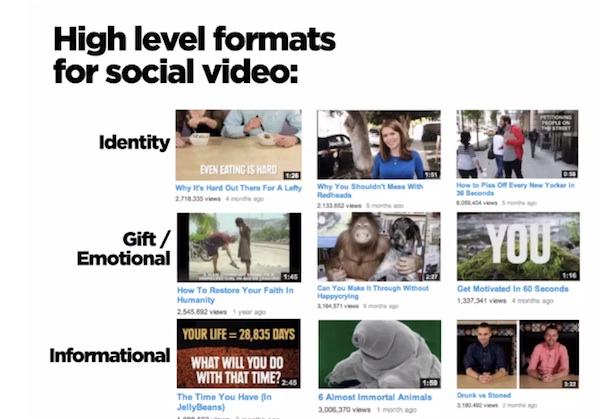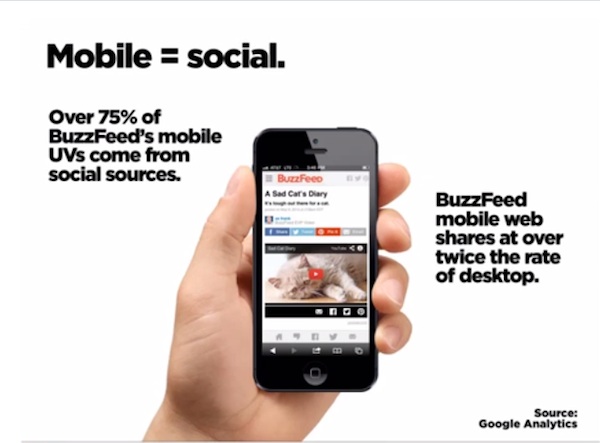
A year ago, Ze Frank — Internet “virologist,” creator of the beloved the show with zefrank, and online video pioneer — was tapped to head BuzzFeed’s video department, based in L.A. Since then, Frank has been striving to create video content with the same impossible-to-ignore qualities that BuzzFeed’s lists have become known for.
With 2.5 million subscribers and around 500 million views, Frank has made some progress, and in a webinar last week, he attempted to describe the elements of social video, both in terms of how to create the content and how to release it into the world.
Over the last year, BuzzFeed Video’s staff has increased from one employee to 32 — Frank said he looks for “soup-to-nuts” video producers who feel comfortable doing a variety of video production tasks. “I was obsessed with not having this crazy division of labor that I think perpetuates the formats of yesterday,” he said, adding that video shouldn’t be seen as a “high-friction product.”
At its base, BuzzFeed Video is doing what we already know news companies also want to do with digital video — harness the combined power of social and mobile. There’s opportunity in the video news space, and it’s a safe bet that BuzzFeed will aim for a piece of it.
“On mobile, the peak video consumption hour is during prime time — which is crazy if you think about that as a competitive landscape,” said Frank. “Online video is competing with the best television programming out there.”

Much of what BuzzFeed is doing with video is merely familiar territory in a new format; a close analysis of why people share media, not in the sense of how large networks function, but in the sense of why an individual makes a single, social decision. Frank summed up the core idea behind social video with this image:

“Captain Picard face-palming is the best way of describing disbelief in something. Not just disbelief, but utter disappointed disbelief,” he said. “This kind of repurposing of media not for consumption but for communication is, I think, the underpinning of this social age.”
In other words, Frank wants to create video content that helps people talk to one another. What goes into making that kind of content? Much as with BuzzFeed’s written content, it breaks down into categories of social role, which Frank thinks of in terms of “share statements.”
For example, if you know somebody is going through a hard time, you might want to share with them a video called “How to Restore Your Faith in Humanity” — that’s emotional content.
If you’re trying to show a friend from New York, in Frank’s words, “I know you, I like you,” you might want to show them, “How to Piss Off Every New Yorker in 36 Seconds” — that’s identity-based content.
And finally, there’s informational content, which is often shared via what Frank calls the humblebrag — you share “Drunk vs. Stoned” to show you know a thing or two about being drunk, stoned, or both.
Drunk vs Stoned – my favorite BuzzFeed video ever. http://t.co/M9d6jrYifM
— Winter Anne Lurchin' (@summeranne) August 22, 2013
The content piece, however, is only one element of the larger ecosystem in which we share media. Creators of shareable video must also consider the network, be it YouTube, BuzzFeed.com, Facebook, Twitter, Tumblr, or beyond. Frank said these are more complicated than we think. Only 10 percent of BuzzFeed’s video views come from YouTube subscribers, and only 6 percent come from BuzzFeed itself. Figuring out the nuances of where the rest of the audience is coming from — for example, that Facebook is a better sharing tool for emotional content while Twitter is better for informational content — is essential.
Likewise, how a video shares inside that ecosystem is also affected by its framing, including the thumbnails, titling, and general message around the content, said Frank. For example, Frank said that one of the most shared New York Times articles of 2006 was called “What Shamu Taught Me About a Happy Marriage.” “What I love about framing is that it’s very clear who you should be sharing this with,” he said. “There’s a very solid reinforcement that you should be sharing this with husbands, people who have husbands, people in relationships.”
Chunking your audience into smaller groups might seem counterintuitive to video producers used to creating content with mass appeal.
“Most programming, from a media standpoint, from a video standpoint, has been thinking about the audience that you’ve captured in some sort a funnel that’s available to you,” said Frank. “Then what you would do is program against that funnel by trying to understand the demographics that are there, the interests, and things like that.”

But if you create video content with “emotional force…strong enough that people will be motivated to share it with others,” your audience becomes “almost unlimited,” he said. That, in a nutshell, is the promise of social video.
Much of BuzzFeed’s video content can still seem off-voice to regular BuzzFeed readers, and it’s certainly still not what the brand is known for. But video provides a major revenue opportunity for all online media companies, especially those already expert in getting eyeballs on their content. At the end of the day, BuzzFeed wants to be the expert in social content, no matter where it lives — on your phone, your tablet, or your desktop — or what shape it comes in.
“I don’t know if we’ve really put the time in, culturally, or as a collection of media businesses, into trying to determine which are the best formats for this kind of communication,” said Frank. “We’re still babies at it.”
Slideshow images by Ze Frank.